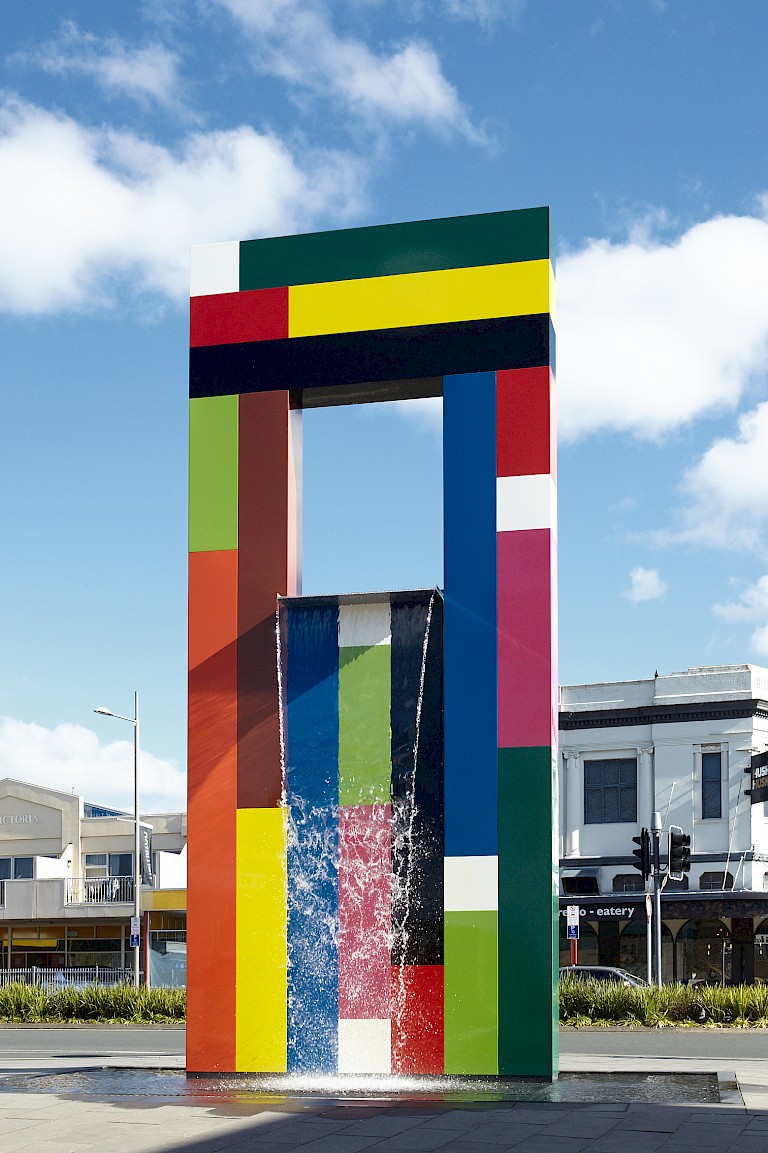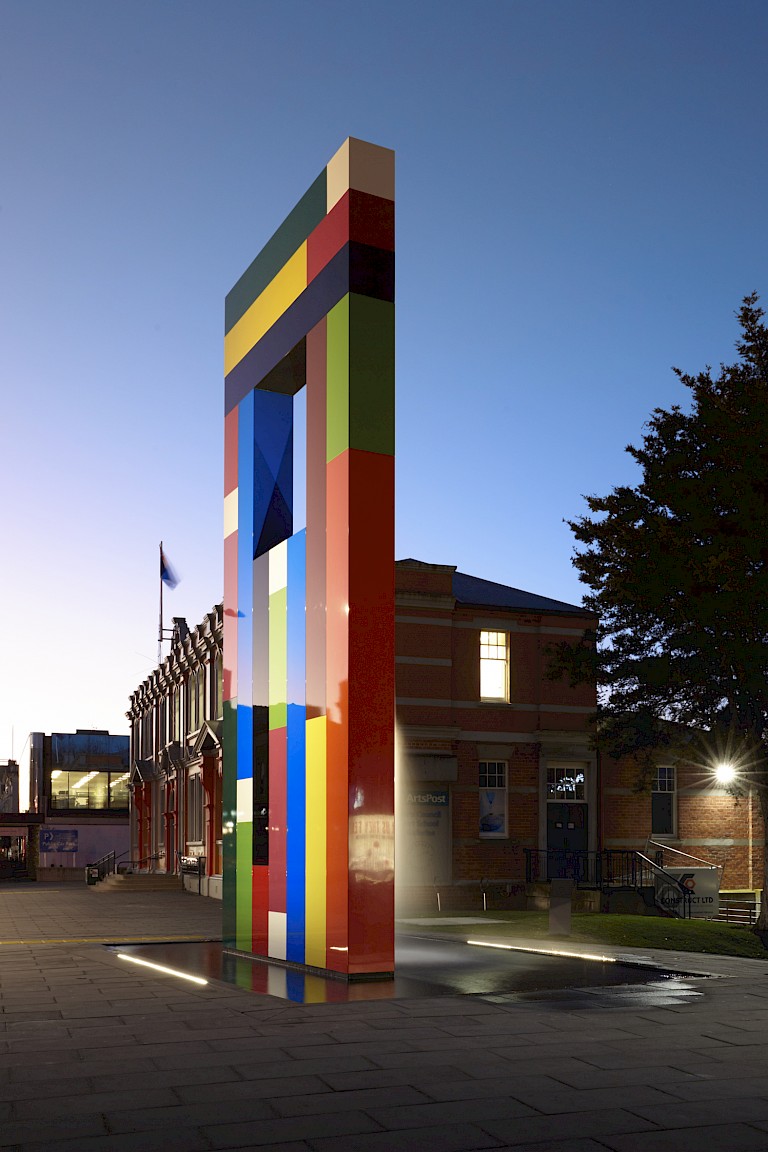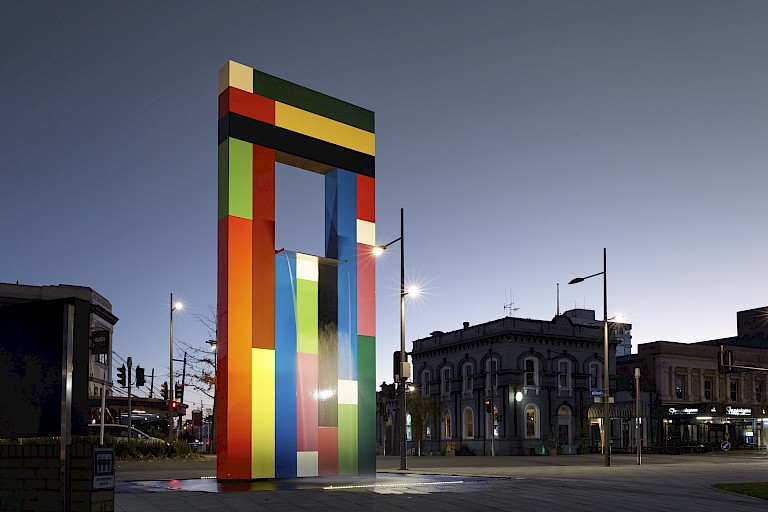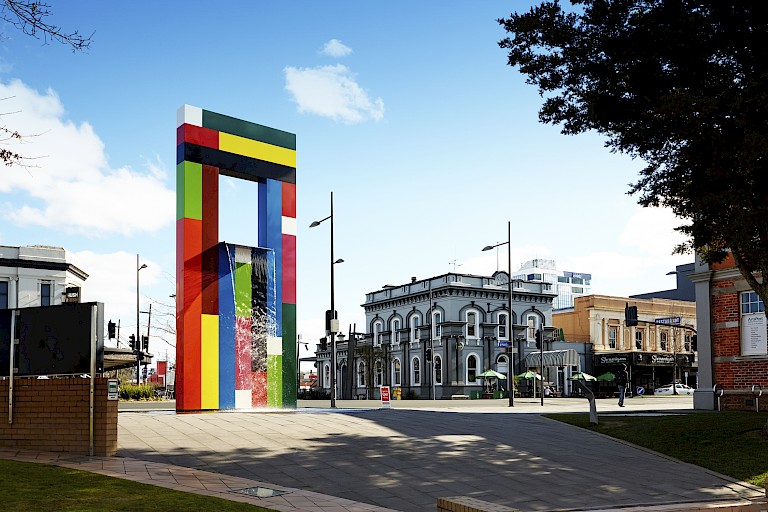Tongue of the Dog
Artist: Michael Parekowhai
Location: Oceania
Year of Completion: 2016
Researcher: Kelly Carmichael
Michael Parekowhai is an artist from Aotearoa-New Zealand of Ngā Ariki Kaiputahi, Ngāti Whakarongo and Pākehā (European) descent. Parekowhai creates work across a wide range of materials and vastly diverse output, including sculpture, photography and installation. His practice offers complex and open-ended narratives, weaving multilayered cultural references drawn from a rich vein of vernacular and high-art vocabularies. Parekowhai’s signature fusion of appropriated and imported concepts recast with a distinctly homegrown spin explores perceptions of place and nationhood and prompts consideration of complex societal situations.
Tongue of the Dog (2016) is a towering sculpture in the city of Hamilton, New Zealand. It sits in the heart of city’s Cultural Precinct above the Waikato Museum. Behind the museum is the Waikato River, the longest river in New Zealand and source of great spiritual meaning for local Māori. Almost three-storeys high, the art work’s striking appearance is created by a number of brightly coloured segments and a square window placed high up on the sculpture, from which a tongue of water falls into a shallow pool, within which the entire work sits. Set against the predominantly two story heritage architecture of Victoria Street - a mixture of late Victorian, Edwardian Baroque and the odd modern building — and the late 1980s yellow clay brick Waikato Museum, Tongue of the Dog presents a striking contemporary addition to the skyline. A series of small but important positioning devices distinguish the art work: the sculpture is slightly offset from parallel to the road and pavement to angle the work towards the Waikato River, the water spills from the river side of the sculpture to make a visual connection to the river below, and the shallow pool of water at ground level is sunk into the ground meaning that no physical or visual barrier separates the work from the viewer or its surrounds.
Tongue of the Dog is an art work which operates effortlessly in the international language of contemporary art, yet is richly layered with multiple local references. The brightly coloured segments reminiscent of Mondrian which form Tongue of the Dog are giant enlargements of Cuisenaire rods, recognisable to most who have been through the New Zealand education system. A recurring motif in Parekowhai’s practice, Cuisenaire rods are an educational tool used for teaching number relations and helping children visualise mathematical concepts. Each uniquely coloured rod is assigned a number value, the rods incrementally growing by one centimetre as they advance through the numbers. Popular in New Zealand early education, the brightly coloured rods are a fun and instantly recognisable tool from school days. More recently the Cuisenaire rods have been used to teach languages, including te reo Māori, by a method known as Te Ataarangi.
That Michael Parekowhai chose to make a sculpture including water in this location is no coincidence. Hamilton is a city defined by its river, historically and currently. Connecting thawing ice and snow from the alpine volcanos of the Central Plateau to the tempestuous Tasman Sea, the Waikato is some 425 kilometres in length. Fed by around 5000 streams, it drives the turbines of nine hydroelectric power stations and passes through the territory of numerous Māori iwi (tribes). Some of the most productive agricultural and horticultural land in the country, the Waikato basin has an important role in the indigenous and colonial history of New Zealand. Along the river is Tūrangawaewae marae, the seat of the Kīngitanga—the Māori King movement—and home of the current King. The tribes of the Waikato are river people — generations of Waikato Māori have lived close to the river and it is deeply important to them. The Waikato River is a tupuna (ancestor), a taonga (treasure), and the mauri (life force) of its people. It lies at the heart of tribal identity and chiefly power. Given this cultural importance and the special relationship between the River and its iwi, many believe that the Waikato will soon follow the Whanganui River, which in 2017 gained its own legal identity with all the corresponding rights, duties and liabilities of a legal person.
Tongue of the Dog connects to the history and cultural importance of the Waikato, embracing a Māori creation legend that speaks to and connects the peoples of this area, without privileging any one iwi. Characteristic of Michael Parekowhai’s practice, the legend is of the people but above politics, distinct and personal, yet open ended and inclusive. “I make objects that set a scene or present a stage on which other things can happen, on which the real art can take place” Parekowhai has previously commented about his work. Inspiration for the sculpture came from a story retold inside the museum adjacent to the art work’s site, which speaks about the creation of the Waikato River. The ancient legend begins with siblings Tongariro and Taupiri Mountains living side-by-side until marriage took Taupiri away to her new home, where she soon became ill. Taupiri believed that only the waters of her homeland could heal her so she sent a message to ask Tongariro to deliver her its healing waters. Tongariro sent his faithful servant, in the form of a dog, to cut a pathway for the waters of Tongariro to reach Taupiri. The river along this pathway became known as Waikato te Awa (Waikato River). The sculpture's tongue of water is the symbolic tongue of this dog.
Before the area was colonised by European settlers, Māori who lived in this area were river-facing. However, the founders of Hamilton, the largest settlement along the Waikato, build the city up high away from the river. This was for practical reasons, such as flooding, but perhaps also to strike a difference and mark the authority and new cultural values of the colonisers. In recent decades numerous attempts have been made to develop a plan to activate the city’s engagement with the river, none have succeeded. A current plan by Hamilton City Council to start turning the city to embrace the river is underway, and a public recreation space that connects central Hamilton to the river has recently opened. While Tongue of the Dog is not an official part of this plan, many of its goals are echoed or anticipated by the artist and art work, including how water spills out of the river side of the sculpture to make a visual connection to the Waikato River below. Tongue of the Dog is returning and reorienting the settlement to the river, connecting the people to an ancient ancestor and source of life, nourishment, transport and cultural significance. To further connect people, place, and the river, the commissioners of Tongue of the Dog have involved local children from the total immersion Māori language school Toku Mapihi Maurea Kura Kaupapa as kaitiaki (or guardians) for the art work.
Cultural interplay between the old and new world has long been a rich and rewarding line of artistic enquiry for artist Michael Parekowhai. The Cuisenaire rods, a repeating motif in his work, can be seen as metaphors for biculturalism, communication, and education. Tongue of the Dog, like much of Parekowhai’s practice, creates a distinct way of reflecting the complex and still forming identity of Aotearoa-New Zealand, weaving layers of meaning and significance with distinctly local references, popular culture, and what has been described as an “…odd alloy of craftiness and conceptualism.”
Image Credits: Mark Hamilton | MESH Sculpture Hamilton
All copyright belongs to Shanghai Academy of Fine Arts, Shanghai University.








